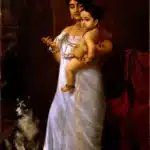Image Courtesy: Google Doodle
Khalil Gibran (6 January 1883 – 10 April 1931) was a Lebanese American artist, poet, and writer. He is best known for his 1923 book “The Prophet,” a series of philosophical essays written in poetic form that has been translated into more than 40 languages and has sold millions of copies worldwide.
Life and Career
Khalil Gibran was born in the village of Bsharri in the mountains of northern Lebanon on 6 January 1883. He was the son of a poor Maronite Christian family, and his early life was marked by tragedy. His mother died when he was young, and his father was imprisoned for debt when Khalil was just a boy. Despite these hardships, Gibran received a good education and showed an early talent for art and literature.
In 1895, at the age of 12, Gibran immigrated to the United States with his family. They settled in Boston, where Gibran attended school and worked as an apprentice artist. He quickly gained recognition for his talent and became a successful painter and illustrator, exhibiting his work in galleries and winning numerous awards.
In the early 1900s, Gibran began to focus more on writing, and his poems and essays were published in a variety of magazines and newspapers. In 1923, he published “The Prophet,” a book of philosophical essays written in poetic form that became an international bestseller and solidified his reputation as a leading intellectual and artist.
Gibran continued to write and paint until his death on 10 April 1931 at the age of 48. Today, he is remembered as one of the most important figures in modern Arabic literature and is widely considered a literary and artistic genius.
Notable Works
Khalil Gibran, a Lebanese-American writer, poet, visual artist, and philosopher, is best known for his poetic essays, which blend elements of Eastern and Western philosophy. Here are some of his most notable works:
- “The Prophet” (1923): This is undoubtedly Gibran’s masterpiece. It’s a collection of poetic essays organized into 26 prose poetry fables. These essays cover topics such as love, marriage, work, freedom, and death, and are delivered by the book’s protagonist, Almustafa, who shares wisdom with the people of Orphalese before returning to his island birthplace.
- “Broken Wings” (1912): This is an autobiographical novel written in Arabic early in Gibran’s career. It tells the story of a tragic love affair between the young protagonist and Selma Karamy in turn-of-the-century Beirut. The novel is a reflection on freedom, love, and social convention.
- “Jesus, The Son of Man” (1928): In this work, Gibran presents Jesus through the eyes of various characters who knew him, including some who followed him and some who rejected him. Each character provides their own perspective on Jesus, offering a multifaceted portrayal of his life and teachings.
- “The Madman” (1918): This was Gibran’s first book published in English. It’s a collection of parables and poems, which explore themes of freedom from societal norms and the discovery of one’s inner self. The opening poem, “How I Became a Madman,” sets the tone for the book’s exploration of the fine line between madness and enlightenment.
- “Sand and Foam” (1926): This book is a collection of profound and poetic aphorisms that Gibran wrote during his lifetime. The work is often philosophical, touching on life’s great questions and the mysteries of the human condition.
- “The Earth Gods” (1931): This is one of Gibran’s later works, a poetic narrative that delves into themes of love and loss through the conversations of the earth gods. It’s known for its rich language and deep philosophical insights.
He has equally dedicated his literary time to Arabic. He has written numerous masterpieces in the language. Here are a few:
- In Arabic2:
- A Profile of the Art of Music (1905)
- Nymphs of the Valley (1906)
- Spirits Rebellious (1908)
- Broken Wings (1912)
- A Tear and a Smile (1914)
- The Processions (1919)
- The Tempests (1920)
- The New and the Marvelous (1923)
Gibran’s writings have been translated into more than twenty languages, and his books have sold millions of copies worldwide. His work continues to inspire readers with its timeless messages of peace, spiritual love, and humanity’s interconnectedness.
Award and Legacy
Khalil Gibran received numerous awards and accolades during his lifetime and after his death. He was a successful artist and his paintings and illustrations were exhibited in galleries and won several awards.
In terms of his writing, Gibran’s most famous work is “The Prophet,” a book of philosophical essays written in poetic form that has been translated into more than 40 languages and has sold millions of copies worldwide. The book has been hailed as a masterpiece of modern Arabic literature and has inspired countless readers with its messages of love, wisdom, and spiritual growth.
Gibran’s legacy extends beyond his artistic and literary achievements. He is remembered as a leading intellectual and spiritual thinker whose ideas have had a profound impact on people around the world. His work continues to be studied and admired by scholars and readers alike, and his ideas about art, love and spiritual growth continue to inspire and influence people today.
In a testament to his enduring legacy, numerous landmarks and educational institutions worldwide bear the name of the esteemed writer and artist, Khalil Gibran. Among these, the Gibran Museum in his Lebanese hometown of Bsharri stands as a significant tribute, while the Gibran Memorial Plaque in Boston’s Copley Square offers a poignant reminder of his influence in the United States. Further honoring his memory are the Gibran Khalil Gibran Garden in Beirut and the Kahlil Gibran Memorial Garden in Washington, D.C., both of which serve as serene spaces for reflection. The educational sphere pays homage to Gibran through the Khalil Gibran International Academy in Brooklyn and the Khalil Gibran Elementary School in Yonkers, NY, illustrating the impact of his philosophies on future generations. In a celestial nod to his legacy, a crater on Mercury was officially named in honor of Gibran in 2009, cementing his place not only in literary history but also in the vast expanse of the cosmos.
On 6 January 2011, Google Doodle celebrated Khalil Gibran’s Birthday.
FAQ on Khalil Gibran
Here are a few Frequently Asked Questions about Khalil Gibran:
1. Who was Khalil Gibran?
Khalil Gibran was a Lebanese-American writer, poet, visual artist, and philosopher, born on January 6, 1883, in the town of Bsharri, in modern-day Lebanon. He emigrated with his mother and siblings to the United States in 1895. Gibran is renowned for his profound and inspirational works that blend elements of Eastern and Western philosophy.
2. What is Khalil Gibran best known for?
Gibran is best known for his book “The Prophet,” a series of poetic essays covering life’s essential topics such as love, marriage, work, and freedom. Since its publication in 1923, “The Prophet” has become one of the best-selling books of the 20th century and has been translated into over 50 languages.
3. Did Khalil Gibran write in English or Arabic?
Gibran wrote in both English and Arabic. His early works were primarily in Arabic, while his later works were mostly in English. “The Prophet” and many of his other well-known works were written in English.
4. How has Khalil Gibran influenced modern thought?
Gibran’s works have had a significant impact on modern thought, particularly in the fields of philosophy and spirituality. His writings, which often explore themes of love, freedom, and the quest for inner peace, have inspired millions worldwide. Gibran’s influence can be seen in the realms of literature, art, and popular culture.
5. Are there any museums dedicated to Khalil Gibran?
Yes, the Gibran Museum in Bsharri, Lebanon, is dedicated to his life and work. The museum, formerly the Monastery of Mar Sarkis, houses Gibran’s personal belongings, manuscripts, letters, and his art studio. It also contains his final resting place.
6. What was Khalil Gibran’s philosophy?
Gibran’s philosophy was a blend of Eastern and Western spiritual ideals. He believed in the unity of all religions and the commonality of human experiences. Gibran emphasized love, freedom, and the pursuit of happiness as central to human existence.
7. Did Khalil Gibran have any significant relationships?
While Gibran never married, he had several significant relationships throughout his life, most notably with Mary Haskell, a school headmistress from Boston. Haskell was a close friend, mentor, and patron of Gibran’s work. Their extensive correspondence over the years provides deep insights into Gibran’s thoughts and development as a writer.
8. When did Khalil Gibran die?
Khalil Gibran passed away on April 10, 1931, in New York City, at the age of 48, due to cirrhosis of the liver and tuberculosis.
9. How can I start reading Khalil Gibran’s works?
A good starting point is “The Prophet,” given its universal themes and accessibility. From there, readers may explore his other English works like “The Madman,” “Sand and Foam,” and “Jesus, The Son of Man.” For those interested in his Arabic writings, “Broken Wings” and “Spirits Rebellious” are excellent choices.
10. Where can I find Khalil Gibran’s art?
In addition to the Gibran Museum in Lebanon, Gibran’s artwork has been exhibited in galleries around the world, including the Telfair Museums in Savannah, Georgia. His art, like his literary works, reflects his interest in mysticism, beauty, and the human condition.







